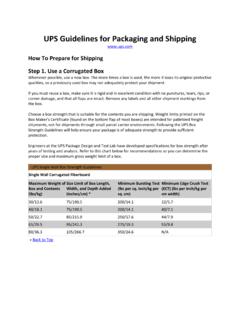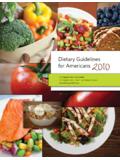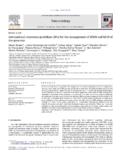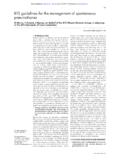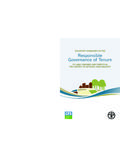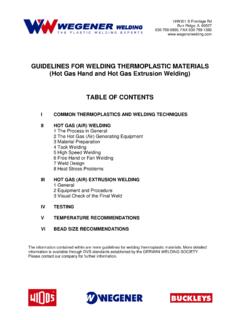Transcription of UPS Guidelines for Packaging and Shipping - …
1 UPS Guidelines for Packaging and Shipping How To Prepare for Shipping Step 1. Use a Corrugated Box Whenever possible, use a new box. The more times a box is used, the more it loses its original protective qualities, so a previously used box may not adequately protect your shipment. If you must reuse a box, make sure it is rigid and in excellent condition with no punctures, tears, rips, or corner damage, and that all flaps are intact. Remove any labels and all other shipment markings from the box. Choose a box strength that is suitable for the contents you are Shipping . Weight limits printed on the Box Maker's Certificate (found on the bottom flap of most boxes) are intended for palletized freight shipments, not for shipments through small parcel carrier environments. Following the UPS Box Strength Guidelines will help ensure your package is of adequate strength to provide sufficient protection.
2 Engineers at the UPS Package Design and Test Lab have developed specifications for box strength after years of testing and analysis. Refer to this chart below for recommendations so you can determine the proper size and maximum gross weight limit of a box. UPS Single Wall Box Strength Guidelines Single Wall Corrugated Fiberboard Maximum Weight of Box and Contents (lbs/kg) Size Limit of Box Length, Width, and Depth Added (inches/cm) * Minimum Bursting Test (lbs per sq. inch/kg per sq. cm) Minimum Edge Crush Test (ECT) (lbs per inch/kg per cm width) 30 75 200 32 40 75 200 40 50 85 250 44 65 95 275 55 80 105 350 N/A Back to Top UPS Double Wall Box Strength Guidelines Double Wall Corrugated Fiberboard Maximum Weight of Box and Contents (lbs/kg) Size Limit of Box Length, Width, and Depth Added (inches/cm) * Minimum Bursting Test (lbs per sq.)
3 Inch/kg per sq. cm) Minimum Edge Crush Test (ECT) (lbs per inch/kg per cm width) 60 85 200 48 80 95 275 51/9 100 105 350 61 120 110 400 71 140 115 500 82 150/68 120 600 N/A Back to Top The above box strengths are only Guidelines to help assure the containment and protection of products transported through single-package distribution environments. They are not to be considered Packaging specifications, and all packaged products should be tested in accordance with the International Safe Transit (ISTA) Test Procedure 3A to ensure the most appropriate level of product protection is achieved. *Note: Maximum size limit specified on the Box Maker's Certificate and the box strength Guidelines chart is NOT the same as the UPS combined length and girth measurement.
4 Calculate the maximum box size by adding the length, width, and depth dimensions of the box together. Step 2. Provide Internal Protection It is important to cushion the contents of your package properly. Please be sure that you wrap each item separately. Fragile articles need separation from each other, and from the corners, sides, top, and bottom of the box. Each item should be surrounded by at least two inches ( cm) of cushioning and be placed at least two inches ( cm) away from the walls of the box. This prevents product-against-product damage and protects contents from shock and vibration, which can pass from the outside of the box to the contents. Please use proper cushioning material, combined with a strong outer container, to protect your shipment fully. Make sure you use enough cushioning material to ensure that the contents do not move when you shake the container.
5 Improper cushioning material includes clothing, blankets, towels, newspaper/newsprint, and pillows. Instead, please use the materials listed below to cushion and protect your shipment: Air-encapsulated plastic (small and large cell bubble sheeting) Designed to protect and cushion lightweight items Used in multiple wraps and layers to ensure that the item is completely protected, especially on corners and edges Inflatable Packaging (air bags) Used primarily as void-fill materials for lightweight items Not recommended for items with sharp corners or edges Extreme hot or cold temperatures may affect the ability of air bags to provide adequate product protection. Expanded polystyrene "peanuts" (loose fill) Used primarily as void-fill material for lightweight items Overfill the box with loose fill, gently close the flaps, and seal securely Do not use with flat or narrow products that may move to the edge or bottom of the carton in transit Due to the shifting and settling properties of peanuts, it is recommended that a minimum of two inches ( cm) of cushioning be used around the contents It is recommended that flat pieces of corrugated fiberboard be used between contents and peanuts to help prevent migration through the peanuts Peanuts cause static electricity and may damage electronic items.
6 Anti-static peanuts should be used for electronic items. Use plastic bags, bubble sheeting, or other items to wrap the item so peanuts will not work themselves into areas that may cause harm to your merchandise. Engineered foam enclosures Materials may include expanded polystyrene, polyethylene, polypropylene, or copolymers Enclosures should be pre-engineered for specific products Foam-in-place/Foam-in-bag A foam, sprayed into the box or mixed in packets, that expands and forms a protective mold around contents Must be properly used, with even foam distribution around the contents Because this material is offered in varying densities, it is important to select the most appropriate foam to meet the requirements of the product Corrugated liners and inserts May be added to the package to increase strength and improve package performance Crumpled kraft paper Used primarily as a void-fill material for light-to-medium weight.
7 Non-fragile items and items that are suitable for such packing materials Must be tightly crumpled Place at least two inches ( cm) of paper between contents and outer box Note: Fragile objects such as electronics, glass, ceramics, and artwork, require special Packaging for safe shipment. Packages containing these and similar items may require added cushioning or a double (over) box. Step 3. Close Your Container Securely Proper closure of your container is just as important as proper cushioning for the safety and security of your shipment. To close a box securely, do not use masking tape, cellophane tape, duct tape, string, or paper over-wrap. Instead, use a strong tape -- two inches ( cm) or more in width -- such as these types: Pressure-sensitive plastic Generally the easiest, most convenient tape to use Versatile because it adheres without water and sticks to a variety of surfaces and shapes Apply three strips to both the top and bottom flaps of the box.
8 For regular slotted containers (RSC), where the flaps meet in the center, apply three strips of tape to both the top and bottom of the box, so the middle and two edge seams are sealed. For corrugated containers where the flaps overlap (FOL), apply three strips of tape to both the top and bottom of the box, so the three edge seams are sealed. Nylon reinforced filament tape Use 60 lb (27 kg) grade tape at least three inches ( cm) wide Apply three strips to both the top and bottom flaps of the box. For regular slotted containers (RSC), where the flaps meet in the center, apply three strips of tape to both the top and bottom of the box, so the middle and two edge seams are sealed. For corrugated containers where the flaps overlap (FOL), apply three strips of tape to both the top and bottom of the box, so the three edge seams are sealed.
9 Step 4. Use Proper Labeling For fast and efficient delivery, keep these points in mind when labeling your package: Always include the recipient s postal code with the complete street address. For international shipments, include a contact name, telephone number, and postal code. You must make every effort to obtain a street address. If a shipper should use a Box address, the recipient s telephone number must be included on the label. Your package that is addressed to a Box may be delayed, will not be covered by any UPS Service Guarantee, and will require an address correction charge. Army Post Office (APO) and Fleet Post Office (FPO) addresses are not accepted. Please include the apartment or unit number, if applicable. Place the Shipping label on the top of the package. To avoid confusion, place only one address label on the package.
10 If you are using a packing slip, place it on the same surface of the package as the address label. Do not place the label over a seam or closure or on top of sealing tape. Remove or cross out old labels or markings on a used box. Always include your complete return address, including full street address and postal code. For international shipments, include a contact name, telephone number, and postal code. Place a duplicate label or other form of identification inside your package. Note: If you are using a mailing tube, place the label horizontally, with each end of the label pointing toward the ends of the tube, so the bar code can be scanned. Note: The smart labels produced by UPS WorldShip , UPS Internet Shipping , and UPS OnLine Compatible Vendor Shipping systems include bar codes and routing codes that help ensure accurate routing and prompt delivery of your shipments.
